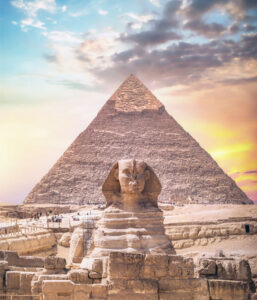The Great Sphinx of Giza is one of the most iconic monuments in the world, standing guard over the Giza Plateau. This colossal limestone statue, with the body of a lion and the head of a human, is believed to represent Pharaoh Khafre, and dates back to approximately 2500 BC.
The Sphinx is shrouded in mystery, with its purpose and origins still debated among historians. Traditionally, it is thought to symbolize strength and wisdom, embodying the power of the Pharaoh. The statue was carved directly from the bedrock of the plateau and originally painted in bright colors, though only traces of this paint remain today.
The Sphinx measures 73 meters (240 feet) in length and 20 meters (66 feet) in height. Its face is over 5 meters (16 feet) wide, and the statue’s gaze is aligned directly with the sunrise on the equinox. Despite centuries of erosion and deliberate damage, the Sphinx remains a powerful symbol of ancient Egypt.
The Sphinx is a major tourist attraction and a central part of the Giza Plateau experience. Visitors can view the statue up close, with the nearby Sphinx Temple providing additional historical context.
